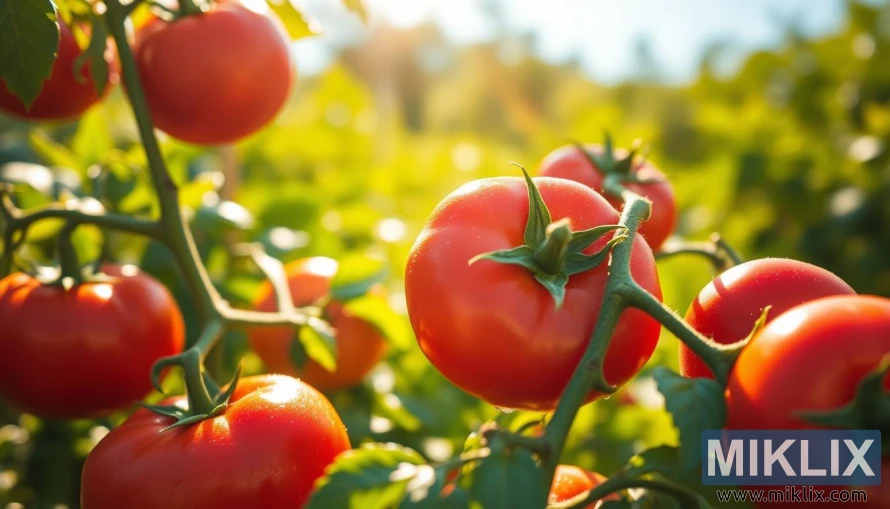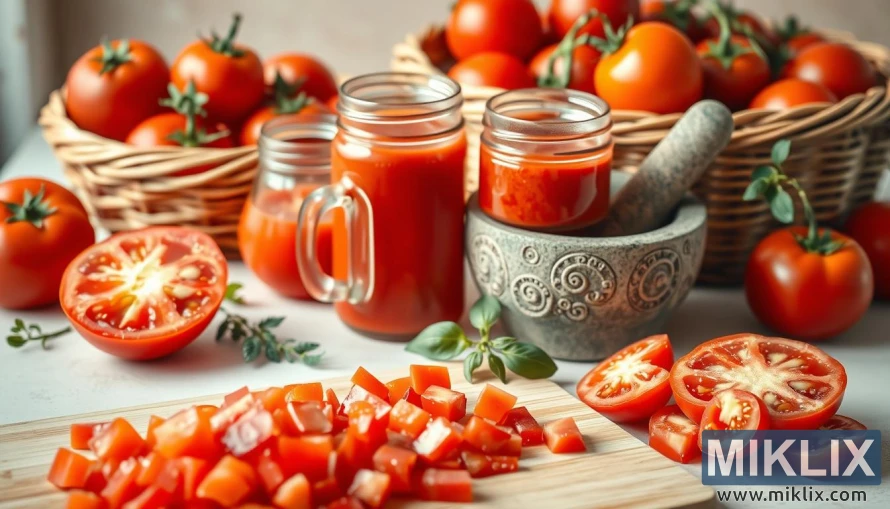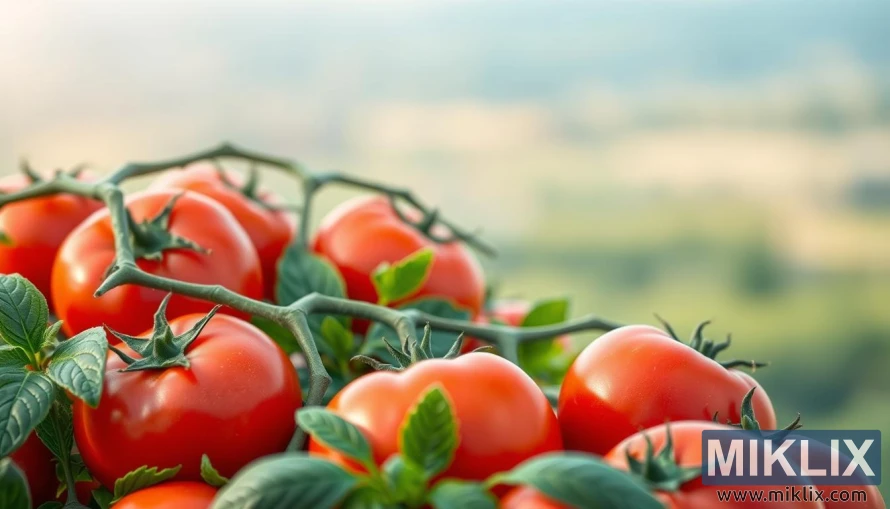Tomatoes, the Unsung Superfood
Published: March 26, 2025 at 6:25:49 PM UTC
Last updated: March 28, 2025 at 3:15:38 PM UTC
Tomatoes are more than just a kitchen favorite. They are a major source of lycopene, an antioxidant that helps lower heart disease and cancer risks. As a fruit from South America, tomatoes are often used as vegetables. They are hydrating, with 95% water content, and low in calories, with only 18 calories per 100 grams. They are rich in vitamin C, fiber, and antioxidants. Adding them to your meals can boost your health.
Tomatoes are good for your overall health. A medium tomato gives you around 35% of the daily vitamin C you need and 1.5 grams of fiber. This helps with digestion and keeps your immune system strong.
Lycopene, found mainly in the skin, is more easily absorbed when tomatoes are processed, like in ketchup or tomato paste. This makes tomatoes a key part of a healthy diet. Ready to learn how tomatoes can improve your health? Let's explore!
Key Takeaways
- Tomatoes are a top dietary source of lycopene, a key antioxidant for heart and cancer risk reduction.
- With 95% water and just 18 calories per 100 grams, they’re hydrating and low in calories.
- Lycopene absorption increases when consumed with fats, making its health benefits better.
- Tomatoes provide significant amounts of vitamin C, supporting skin elasticity, and aid immune function.
- Tomato-based products like ketchup contribute over 80% of Americans’ dietary lycopene intake.
Introduction to the Nutritional Powerhouse: Tomatoes
Tomatoes come from South America and have a long tomato history. They were once thought to be poisonous in Europe. Now, they are a superfood loved worldwide. They belong to the nightshade family and have become a key part of our diet.
Tomatoes are full of nutrients like vitamin C, potassium, and fiber. A medium tomato has only 22 calories, 1.5g of fiber, and 292mg of potassium. They also have a lot of water, which helps with digestion and staying hydrated.
- Vitamin C: 35% daily value
- Vitamin K: 18% daily needs for bone health
- Lycopene: Antioxidant linked to heart and skin benefits
- Low sodium (6mg) and fat (0.2g) for balanced diets
Tomatoes come in many colors and sizes, like cherry and beefsteak. Each color has its own nutrients. They can be eaten raw, cooked, or in sauces. This makes them easy to add to any meal.
The Impressive Nutritional Profile of Tomatoes
Tomatoes are more than just a tasty addition to meals—they're a nutritional powerhouse. With 95% water content, they help keep you hydrated and aid digestion. They have only 18 calories per 100 grams but pack a lot of nutrients.
Tomato vitamins are abundant in every bite. They're full of vitamin C, which boosts immunity, and vitamin K1 for bone health. They also have folate to support cell function. These nutrients meet your body's needs without adding too many calories.
- Minerals in tomatoes include potassium, important for heart and muscle function, and smaller amounts of manganese and phosphorus.
- Dietary fiber (1.2g per 100g) helps keep digestion smooth and makes you feel full.
Tomatoes' nutrient density is their biggest strength. They have a lot of water and vitamins/minerals with few calories. This makes them perfect for those who want to eat more nutrients without eating more. Whether raw or cooked, they're a simple way to add health-boosting nutrients to any meal.
Lycopene: The Star Antioxidant in Tomatoes
Lycopene is the red pigment in tomatoes. It's a strong antioxidant that fights off harmful free radicals. This helps lower oxidative stress, which is linked to chronic diseases.
Processed tomato products like sauce, paste, and ketchup have more bioavailable lycopene than raw tomatoes. This makes them a key part of Western diets.
Cooked tomatoes are better for lycopene absorption. Heat breaks down cell walls, releasing more of this nutrient. Research from Düsseldorf shows cooked tomatoes have up to twice the lycopene of raw ones.
Adding fats like olive oil during cooking boosts absorption by up to four times. This ensures your body uses lycopene efficiently.
- Roast or sauté tomatoes with olive oil to unlock lycopene benefits.
- Choose marinara sauce or tomato paste for concentrated lycopene intake.
- Combine tomatoes with avocado or cheese to boost nutrient absorption.
Studies show lycopene can reduce prostate cancer risk by up to 35% with regular tomato product consumption. It also supports heart health by improving cholesterol balance. By adjusting how you prepare tomatoes, you can maximize these benefits.
Heart Health Benefits of Regular Tomato Consumption
Tomatoes are great for heart health because of lycopene, potassium, and fiber. Eating tomatoes regularly helps with cardiovascular benefits. It targets high blood pressure and cholesterol.
Studies show lycopene can lower bad cholesterol and improve blood vessel function. This reduces the risk of heart attacks and strokes.
A study with 7,056 participants found eating over 110g of tomatoes daily lowers high blood pressure by 36%. Lycopene supplements can lower systolic blood pressure by up to 5.66 mmHg.
High tomato intake also lowers LDL cholesterol. Women eating 10+ servings a week saw lower LDL and triglycerides. Tomato juice drinkers had lower cholesterol and higher heart-protective adiponectin.
Key findings from consumption levels:
- Less than 44g/day: highest hypertension risk
- 44–82g/day: moderate reduction
- 82–110g/day: further improvement
- Over 110g/day: 36% lower hypertension risk
Even small changes can help. EFSA approved a tomato extract for supporting normal platelet activity. For the best heart health, eat tomato-rich meals daily. This can lower cholesterol and blood pressure, making your heart healthier.
Tomatoes and Cancer Prevention
Tomatoes might help lower cancer risk with their special nutrients. Lycopene, a strong antioxidant in tomatoes, is linked to prostate cancer and cancer prevention. Studies show men who ate more tomato-based foods had up to a 40% lower risk of prostate cancer, according to NIH data from 72 studies.
Lycopene's antioxidant protection fights off free radicals that harm cell protection. Tomatoes also have anti-inflammatory compounds that may slow tumor growth by keeping cells healthy. A 2002 study found that higher lycopene intake was linked to a 30% lower risk of oral and esophageal cancers.
- High tomato diets reduced prostate cancer risk by 19%, per a meta-analysis of 21 studies.
- Lab studies show tomato extracts delay tumor progression in mouse models.
- Consuming 5-7 mg of lycopene daily (about two servings of cooked tomatoes) aligns with optimal cancer prevention benefits.
No single food can cure cancer, but tomatoes' nutrients can help when part of a plant-based diet. Eating tomatoes with healthy fats like olive oil boosts lycopene absorption. Avoid processed meats and too much sugar, as they can undo these benefits. With global cancer cases expected to rise, choosing tomato-rich meals could be a simple way to improve long-term health.
How Tomatoes Support Skin Health and Anti-Aging
Tomatoes are more than just a salad topping. They're packed with lycopene and vitamin C, which protect and rejuvenate your skin. Eating tomatoes regularly boosts collagen, a protein that keeps your skin firm and reduces wrinkles. Tomatoes are high in vitamin C, essential for collagen.
A 2006 study found that eating tomato paste with olive oil daily for 10 weeks cut UV sensitivity by 40%. Lycopene acts like an internal sunscreen, protecting skin cells from sun damage. It also fights free radicals that cause early aging. Tomatoes also have B vitamins like B-1 and B-3, which help keep skin moist and may reduce age spots. Potassium in tomatoes keeps skin hydrated, preventing dryness seen in those with dermatitis.
- Collagen boost: Vitamin C in tomatoes strengthens skin elasticity.
- UV defense: Lycopene reduces sunburn risk when eaten with healthy fats like olive oil.
- Anti-aging mix: Antioxidants slow wrinkle formation and improve skin tone.
For anti-aging care, try a DIY face mask with blended tomatoes or add them to meals daily. While most benefit, some may experience redness or itching due to acidity. Pairing tomato consumption with sunscreen offers dual UV protection. Whether eaten raw, cooked, or blended into a mask, tomatoes’ nutrients nourish skin from the inside out.
Digestive Health Advantages of Eating Tomatoes
Tomatoes help with digestive health thanks to their fiber. A medium tomato has 1.5 grams of fiber. Most of this is insoluble fiber, like hemicellulose and cellulose.
This type of fiber makes stool bulkier. It helps with regular bowel movements and prevents constipation. The rest of the fiber feeds good bacteria in the gut, boosting gut health.
Research shows tomatoes are good for the gut. A study at Ohio State University found tomato powder increased good gut bacteria in piglets. This suggests tomatoes might help create a healthier gut environment.
- Eat tomatoes raw or cooked for both insoluble fiber and prebiotics.
- Pair them with probiotic-rich foods like yogurt for extra gut benefits.
- Tomato fiber also helps with digestion for many, but those with acid reflux should watch their intake.
Adding tomatoes to your meals is a simple way to support digestive health. Their fiber works with your body's natural digestion. Enjoy them in salads, salsas, or roasted dishes to keep digestion smooth without losing flavor.
Tomatoes for Weight Management and Metabolic Health
Tomatoes are great for keeping weight in check. They have only 18 calories per 100g. They are full of nutrients but low in calories. This makes them very filling.
The fiber and water in tomatoes help you feel full longer. This can help control hunger. Studies also suggest tomatoes may help burn fat and detoxify the body.
A study with 61 obese kids showed tomatoes can help a lot. Kids who drank tomato juice lost 4kg more than others. They also had better liver health and less inflammation.
This shows tomatoes can improve metabolism and help with weight goals.
- Cherry tomatoes contain 31 calories per 1/2 cup, making them a low-calorie food option.
- Tomatoes' fiber content aids satiety, curbing overeating.
- Tomato juice supplementation was linked to reduced inflammation and improved metabolism in studies.
Add tomatoes to your meals for better metabolic health. They keep you full and fit well into weight management plans. Tomatoes boost metabolism and provide important vitamins, helping you reach your weight goals.
Eye Health and Vision Benefits from Tomatoes
Tomatoes are good for your eyes because they have lutein and zeaxanthin. These nutrients help protect the retina. They also block harmful blue light and fight oxidative damage that can cause vision loss.
Studies show eating tomatoes regularly can lower the risk of age-related macular degeneration. This is the leading cause of blindness in older adults. It can reduce the risk by up to 35%.
Lutein and zeaxanthin fight free radicals and reduce eye inflammation. They are linked to a 25% lower risk of age-related vision problems. These compounds also help reduce eye strain from screens, which can cause headaches and fatigue.
- Tomatoes are a source of vitamin A, vital for maintaining clear vision.
- Vitamin C in tomatoes cuts cataract risk by 30% by strengthening eye tissues.
- Combined with other carotenoids, lutein and zeaxanthin boost antioxidant power beyond individual effects.
Cooked tomatoes have more lycopene, but raw or cooked, they're good for your eyes. Adding tomatoes to salads, sauces, or snacks can help your eye health. Protect your vision naturally with this simple, nutrient-rich addition to meals.
Different Ways to Include More Tomatoes in Your Diet
Tomatoes are versatile in the kitchen, adding flavor and nutrition to meals. Use them in omelets or on avocado toast for vitamin C. For lunch, try caprese salads or homemade salsa for tacos. At dinner, roast them in pasta or on sandwiches.
Preserve tomatoes to enjoy them all year. Freeze whole or chopped tomatoes for soups. Dry them for chewy chips or sauces. Canned tomato sauce is great for cold nights. Cherry tomatoes are tasty as snacks, lightly salted or with herbs.
- Blend into smoothies for a savory twist
- Top bruschetta with fresh basil and garlic
- Roast with garlic for a pasta topper
- Layer into frittatas or quiches
- Mix into tuna or chicken salads
- Grill and serve with mozzarella for a quick appetizer
Cooking with tomatoes brings out their best. Pair them with olive oil for better lycopene absorption. Try Turkish ezme or Spanish gazpacho for unique flavors. Even candied tomatoes add sweetness to salads. There are endless ways to enjoy their rich flavor.
Potential Concerns: Tomato Allergies and Sensitivities
Tomatoes are packed with nutrients, but some people may have bad reactions. Tomato allergies are rare but can cause immune system issues, mainly in those with grass pollen allergies. These issues often lead to mouth itching or throat tightness.
People with nightshade sensitivity might also react to foods like eggplant or peppers. Tomato acidity can make acid reflux worse for some. Symptoms of food sensitivities include stomach pain or skin rashes, different from true allergies.
- Oral allergy syndrome: Mouth tingling or swelling
- Nightshade sensitivity: Joint pain or inflammation
- Acid reflux: Heartburn or indigestion
If you notice symptoms, see an allergist for tests. Those with latex allergies might also react. While tomato allergies affect 1.7-9.3% of some, most cases are mild. Try low-acid tomatoes or cooked ones to lessen irritation. Always get medical advice for serious reactions.
Organic vs. Conventional Tomatoes: Is There a Nutritional Difference?
Choosing between organic and conventional tomatoes is more than just taste. Research suggests organic tomatoes might have more nutrients. A study by the University of Barcelona found organic Daniela tomatoes had 34 phenolic compounds. These compounds help fight diseases and are often found in higher amounts in organic tomatoes.
- Pesticides: Organic farming bans synthetic pesticides, while conventional systems allow their use.
- Nutrient content: Organic methods may boost polyphenols and vitamin C due to natural soil management.
- Sustainable agriculture: Organic practices focus on soil health via compost and crop rotation, reducing environmental impact.
Conventional farming uses artificial ethylene gas to speed up ripening, which can change flavor. Locally sourced tomatoes, even if not organic, might taste better because they ripen naturally. If cost is a concern, buying in-season or growing your own is a good option.
USDA-certified organic tomatoes must follow strict standards, including no synthetic fertilizers. While both types are nutritious, organic options support sustainable agriculture and lower pesticide exposure. Think about what matters most to you: health, taste, or the environment when deciding.
Conclusion: Making Tomatoes a Regular Part of Your Healthy Diet
Tomatoes are packed with nutrients, making them great for a healthy diet. They help protect your heart and fight cancer. With only 22 calories in a medium tomato, they're perfect for daily meals.
Tomatoes are full of lycopene, potassium, and fiber. These nutrients help keep you healthy. Eating them raw in salads or cooked in sauces is a smart move.
Studies show that cooking tomatoes increases their lycopene. This helps lower heart disease risks. Tomatoes also have potassium like bananas, which helps with blood pressure. Their fiber aids digestion and helps with weight management.
Enjoy tomatoes with whole grains or lean proteins for a balanced meal. They're affordable and available all year. Choose organic tomatoes to avoid pesticides, but non-organic ones are healthy too.
Tomatoes are a must-have in a healthy diet. They're low in calories but high in antioxidants. Use them in sandwiches or soups to boost your health. Adding tomatoes to your meals can make a big difference in your well-being.
Nutrition Disclaimer
This page contains information about the nutritional properties of one or more food items or supplements. Such properties may vary worldwide depending on harvest season, soil conditions, animal welfare conditions, other local conditions, etc. Always make sure to check your local sources for specific and up-to-date information relevant to your area. Many countries have official dietary guidelines that should take precedence over anything you read here. You should never disregard professional advice because of something you read on this website.
Furthermore, the information presented on this page is for informational purposes only. While the author has put reasonable effort into verifying the validity of the information and researching the topics covered here, he or she is possibly not a trained professional with a formal education on the subject matter. Always consult with your physician or a professional dietician before making significant changes to your diet or if you have any related concerns.
Medical Disclaimer
All content on this website is for informational purposes only and is not intended to be a substitute for professional advice, medical diagnosis, or treatment. None of the information here should be considered medical advice. You are responsible for your own medical care, treatment, and decisions. Always seek the advice of your physician or another qualified healthcare provider with any questions you may have regarding a medical condition or concerns about one. Never disregard professional medical advice or delay seeking it because of something you have read on this website.




